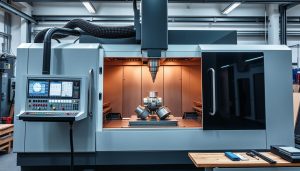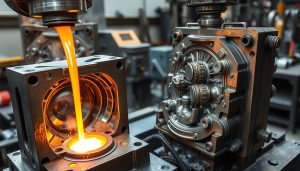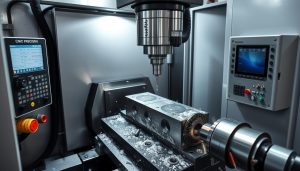In the realm of modern manufacturing, metal fabrication technology plays a crucial role in transforming raw metal materials into diverse and functional products. This encompassing field involves a myriad of processes and techniques, including cutting, bending, welding, and assembling metal components to create a wide range of items for various industries. From the towering skyscrapers that define our skylines to the sleek automobiles that grace our roads, metal fabrication technology is the backbone that brings these innovations to life.
At its core, metal fabrication technology harnesses the power of modern manufacturing methods to shape, mold, and assemble metal parts with unparalleled precision and efficiency. This dynamic field continues to evolve, incorporating cutting-edge advancements in areas such as computer numerical control (CNC) machining, laser cutting, and robotic automation. By leveraging these innovations, metal fabricators are able to produce high-quality, customized products that meet the ever-changing demands of the global marketplace.
Overview of Metal Fabrication
Metal fabrication is a crucial aspect of the manufacturing industry, playing a vital role in transforming raw materials into finished products. This process involves a series of specialized techniques that shape, cut, and join various metals to create components, structures, and assemblies used across a wide range of industries, from aerospace and automotive to construction and consumer goods.
The Role of Metal Fabrication in Manufacturing
Metal fabrication is a fundamental part of the manufacturing process, enabling the production of parts, equipment, and structures that are essential for diverse industries. By leveraging advanced techniques and technologies, metal fabrication professionals can transform metal into customized, high-quality components that meet the specific needs of manufacturers and end-users.
Key Processes Involved in Metal Fabrication
The metal fabrication industry encompasses a range of specialized processes, including:
- Cutting: Techniques such as laser cutting, plasma cutting, and waterjet cutting allow for precise and efficient metal shaping.
- Forming and Bending: Processes like stamping, rolling, and folding are used to give metal the desired shape and contour.
- Joining: Welding, brazing, and other joining methods are employed to assemble metal components into larger structures.
These processes, combined with the expertise of skilled metal fabrication professionals, enable the production of high-quality, customized metal products that are essential for various industries and applications.
“Metal fabrication is the backbone of modern manufacturing, transforming raw materials into the essential components that power our world.”
Types of Metal Fabrication Technology
In the realm of metal fabrication, the industry has witnessed a remarkable evolution, transitioning from traditional techniques to embracing cutting-edge modern methods. This evolution has revolutionized the way manufacturers approach metal cutting technologies, forming techniques, and welding methods, unlocking new levels of precision, efficiency, and versatility.
Traditional vs. Modern Fabrication Methods
While traditional fabrication methods such as manual cutting, bending, and welding still hold their place in the industry, the rise of advanced technologies has introduced a new era of metal fabrication. Modern techniques like laser cutting, plasma cutting, and waterjet cutting have become increasingly prevalent, offering unparalleled accuracy, speed, and the ability to handle complex geometries with ease.
Cutting Technologies: Laser Cutting, Plasma Cutting, and Waterjet
Laser cutting, plasma cutting, and waterjet cutting have emerged as the triumvirate of advanced metal cutting technologies. Laser cutting utilizes a focused beam of light to precisely cut through metal, while plasma cutting employs a high-temperature plasma arc for clean, efficient cuts. Waterjet cutting, on the other hand, uses a high-pressure stream of water to slice through even the hardest of materials, making it a versatile choice for intricate designs and sensitive applications.
Bending and Forming Techniques
- Press braking: This method uses a die and punch to bend metal sheets and plates into desired shapes.
- Roll forming: A continuous process that shapes metal by passing it through a series of rollers, creating complex profiles.
- Stamping: Employing a stamping press, this technique punches or shapes metal into specific forms, ideal for large-scale production.
Welding and Joining Technologies
- Gas metal arc welding (GMAW): Also known as MIG welding, this process uses a continuous solid wire electrode to join metal parts.
- Tungsten inert gas (TIG) welding: This manual welding method, also known as GTAW, utilizes a non-consumable tungsten electrode to produce high-quality welds.
- Resistance spot welding: A popular technique for joining sheet metal, it uses electrical resistance to fuse the overlapping metal parts.
These advanced welding methods have become essential tools in the metal fabrication industry, enabling seamless and durable connections between metal components.

“The future of metal fabrication lies in the seamless integration of cutting-edge technologies that push the boundaries of precision, efficiency, and design flexibility.”
The Evolution of Metal Fabrication Technology
Metal fabrication has come a long way from its manual beginnings. Over the decades, this industry has undergone a remarkable transformation, driven by the rapid advancements in automated fabrication, CNC technology, and robotic manufacturing. These innovations have profoundly impacted the efficiency, precision, and cost-effectiveness of metal fabrication processes.
From Manual Techniques to Automation
In the past, metal fabrication relied heavily on manual techniques, where skilled workers used hand tools and physical labor to shape, bend, and join metal components. While this approach allowed for customization, it was often time-consuming, labor-intensive, and prone to inconsistencies. However, the introduction of automated fabrication has revolutionized the industry, enabling manufacturers to streamline their operations and achieve unprecedented levels of productivity.
The Impact of CNC Machines and Robotics
The integration of CNC technology and robotic manufacturing has been a game-changer for metal fabrication. CNC (Computer Numerical Control) machines, equipped with advanced software and precision control, have virtually eliminated manual errors, allowing for the production of intricate, high-quality parts with remarkable consistency. Meanwhile, the incorporation of robotics has further enhanced efficiency, enabling faster, more reliable, and more cost-effective metal fabrication processes.
| Traditional Fabrication | Modern Automated Fabrication |
|---|---|
| Labor-intensive manual techniques | Automated processes driven by CNC machines and robotics |
| Prone to inconsistencies and errors | Increased precision, efficiency, and productivity |
| Slow and time-consuming | Faster turnaround times and cost-effectiveness |
The evolution of metal fabrication technology has been a remarkable journey, transforming the industry from manual techniques to highly automated fabrication powered by CNC technology and robotic manufacturing. These advancements have enabled manufacturers to achieve new levels of precision, efficiency, and cost-effectiveness, positioning the metal fabrication industry for continued growth and innovation.
Advantages of Advanced Metal Fabrication Technology
The advent of modern metal fabrication technology has unlocked a world of possibilities for manufacturers. From enhanced precision manufacturing and efficient production to the flexibility in design and production, these advancements are transforming the industry.
Enhanced Precision and Efficiency
Precision is paramount in today’s manufacturing landscape, and advanced metal fabrication techniques have raised the bar. Computer Numerical Control (CNC) machines and robotic systems have revolutionized the way parts are produced, ensuring unparalleled accuracy and consistency. These technologies enable manufacturers to achieve tighter tolerances, minimize errors, and deliver superior-quality components with remarkable efficiency.
Cost-Effectiveness and Reduced Waste
The implementation of advanced metal fabrication technologies has also significantly improved the cost-effectiveness of production. Automated processes and streamlined workflows have resulted in reduced material waste, lower labor costs, and faster turnaround times. By optimizing resource utilization and minimizing production bottlenecks, manufacturers can enjoy greater profitability and sustainability in their operations.
Flexibility in Design and Production
One of the standout advantages of modern metal fabrication is the unparalleled flexibility it offers. Cutting-edge technologies, such as laser cutting, plasma cutting, and waterjet cutting, allow for intricate and complex designs to be realized with ease. This design flexibility empowers manufacturers to cater to a wide range of customer requirements, adapting their products and services to the evolving market demands.
The future of metal fabrication is undoubtedly bright, with advanced technologies paving the way for unprecedented levels of precision manufacturing, efficient production, and design flexibility. By embracing these innovations, manufacturers can stay ahead of the curve, deliver exceptional value to their customers, and drive the industry forward.

Industries That Benefit from Metal Fabrication Technology
The versatility of metal fabrication technology has made it an indispensable tool across a wide range of industries. From the high-precision demands of aerospace manufacturing to the innovative designs in automotive production and the intricate components of electronics fabrication, this advanced process continues to revolutionize how goods are produced.
Aerospace, Automotive, and Electronics
The aerospace industry relies heavily on metal fabrication techniques to create aircraft parts, satellites, and other mission-critical components. The precision and durability required in this sector make metal fabrication an ideal choice. Similarly, the automotive industry utilizes metal fabrication for everything from body panels to engine parts, ensuring strength, reliability, and innovative designs.
In the electronics industry, metal fabrication is essential for manufacturing circuit boards, housings, and intricate electronics. The ability to precisely cut, bend, and weld metals allows for the creation of compact, efficient, and high-performance electronics that power our modern world.
Construction, Shipbuilding, and Consumer Goods
The construction industry relies on metal fabrication for the production of structural beams, reinforcements, and architectural elements. Metal fabrication techniques enable the creation of durable, customizable, and cost-effective building materials.
Shipbuilding is another industry that benefits greatly from metal fabrication, as it is used to create hulls, decks, and other critical components. The strength and precision of metal fabrication are crucial for ensuring the safety and longevity of marine vessels.
Even in the realm of consumer goods, metal fabrication plays a vital role. From household appliances to outdoor furniture, the ability to shape and assemble metals allows manufacturers to offer a wide range of products that are both functional and aesthetically pleasing.
| Industry | Applications of Metal Fabrication |
|---|---|
| Aerospace | Aircraft parts, satellites, mission-critical components |
| Automotive | Body panels, engine parts, innovative designs |
| Electronics | Circuit boards, housings, intricate components |
| Construction | Structural beams, reinforcements, architectural elements |
| Shipbuilding | Hulls, decks, critical components |
| Consumer Goods | Household appliances, outdoor furniture |
From the high-performance demands of aerospace and automotive manufacturing to the intricate design requirements of electronics and the practical needs of construction and consumer goods, metal fabrication technology continues to play a pivotal role in shaping the products and infrastructure that power our modern world.
Shixinproto’s High Precision Metal Fabrication Services
At Shixinproto, we pride ourselves on delivering high-precision metal fabrication services that cater to the diverse needs of our clients. Our state-of-the-art facilities and skilled team of experts leverage cutting-edge technology to produce custom manufacturing solutions that exceed industry standards.
Whether you’re in the aerospace, automotive, or electronics industry, Shixinproto’s precision metal fabrication services can help bring your ideas to life. Our comprehensive suite of capabilities, including laser cutting, plasma cutting, and advanced welding techniques, ensures that every component we manufacture meets the strictest quality and performance requirements.
But our expertise extends beyond just metal fabrication. We also specialize in industrial prototyping, providing our clients with the opportunity to iterate and refine their designs before committing to full-scale production. By partnering with Shixinproto, you can unlock the full potential of your projects and deliver exceptional, precision-engineered products to the market.





